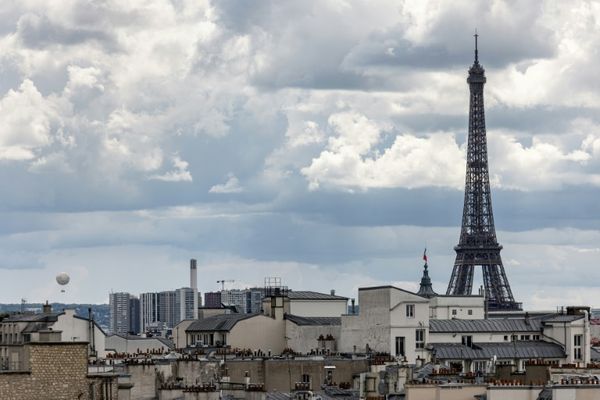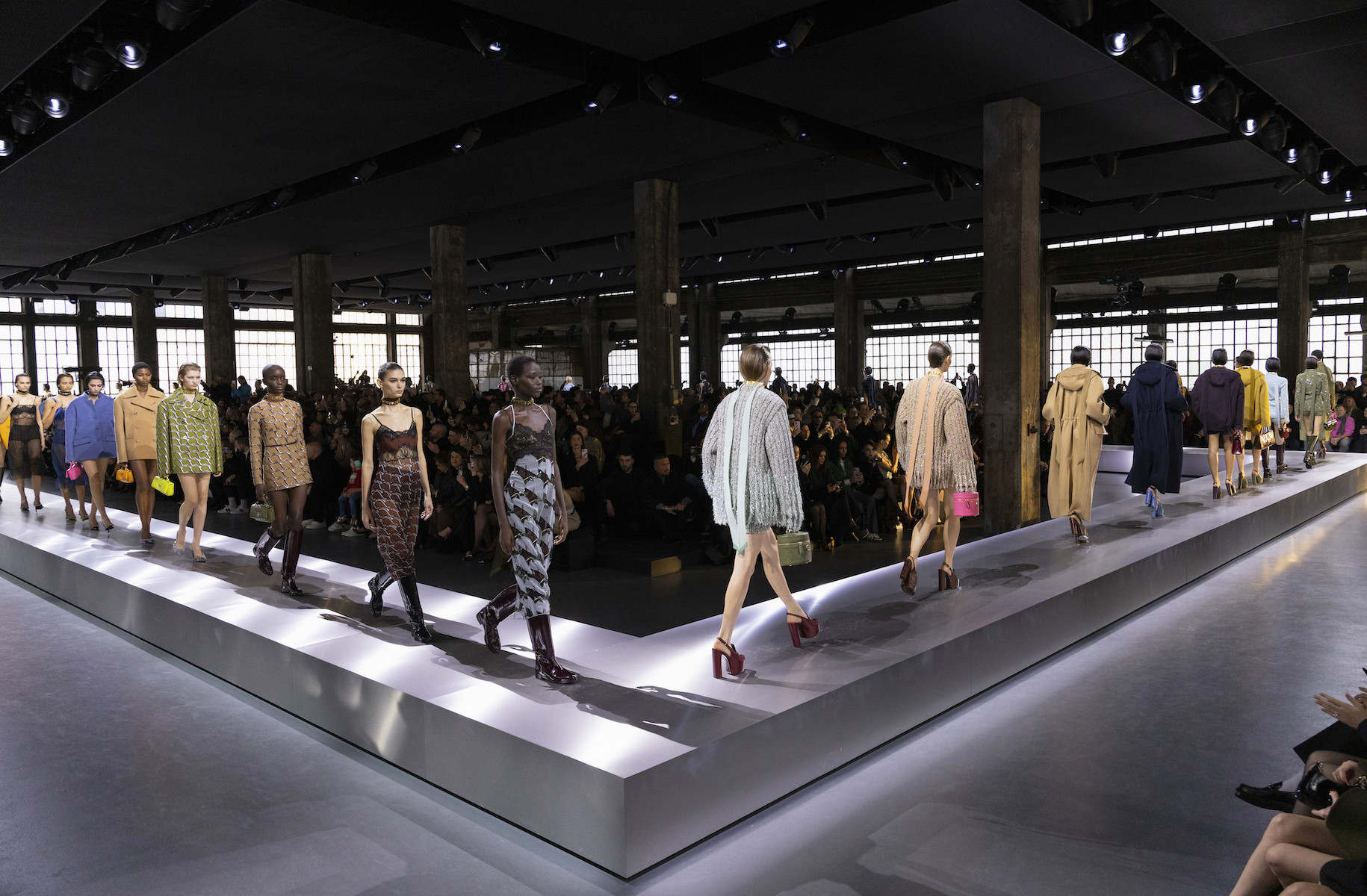
Milan Fashion Week A/W 2024 – which begins in the Italian city this week – looks set to be the season of debuts. Tod’s and Blumarine will both welcome new creative directors: the former sees ex-Bottega Veneta designer Matteo Tamburini take the helm, while at the latter, Walter Chiapponi (formerly of Tod’s) replaces Nicolas Brognano. Moschino will also welcome new creative director Adrian Appiolaza, formerly of Loewe, where he was ready-to-wear design director for ten years. Other notable moments include a return to Milan for Marni, which has in recent seasons shown in Paris, Tokyo and New York.
Elsewhere, we look forward to Prada and the brand‘s latest collaboration with OMA (in January, a striking menswear set clashed the great outdoors with a corporate office), and London-based designer Feben – one of Wallpaper’s designers set to define 2024 – who will make her Milan Fashion Week debut, showing with the support of Dolce & Gabbana on Sunday. Rounding out the schedule are the titans of Italian fashion; among them Giorgio Armani, Max Mara, Gucci, Bottega Veneta, and Dolce & Gabbana.
Here, reporting live from the shows, Wallpaper* fashion features editor Jack Moss picks the best of Milan Fashion Week A/W 2024, as it happens.
The best of Milan Fashion Week A/W 2024
Versace
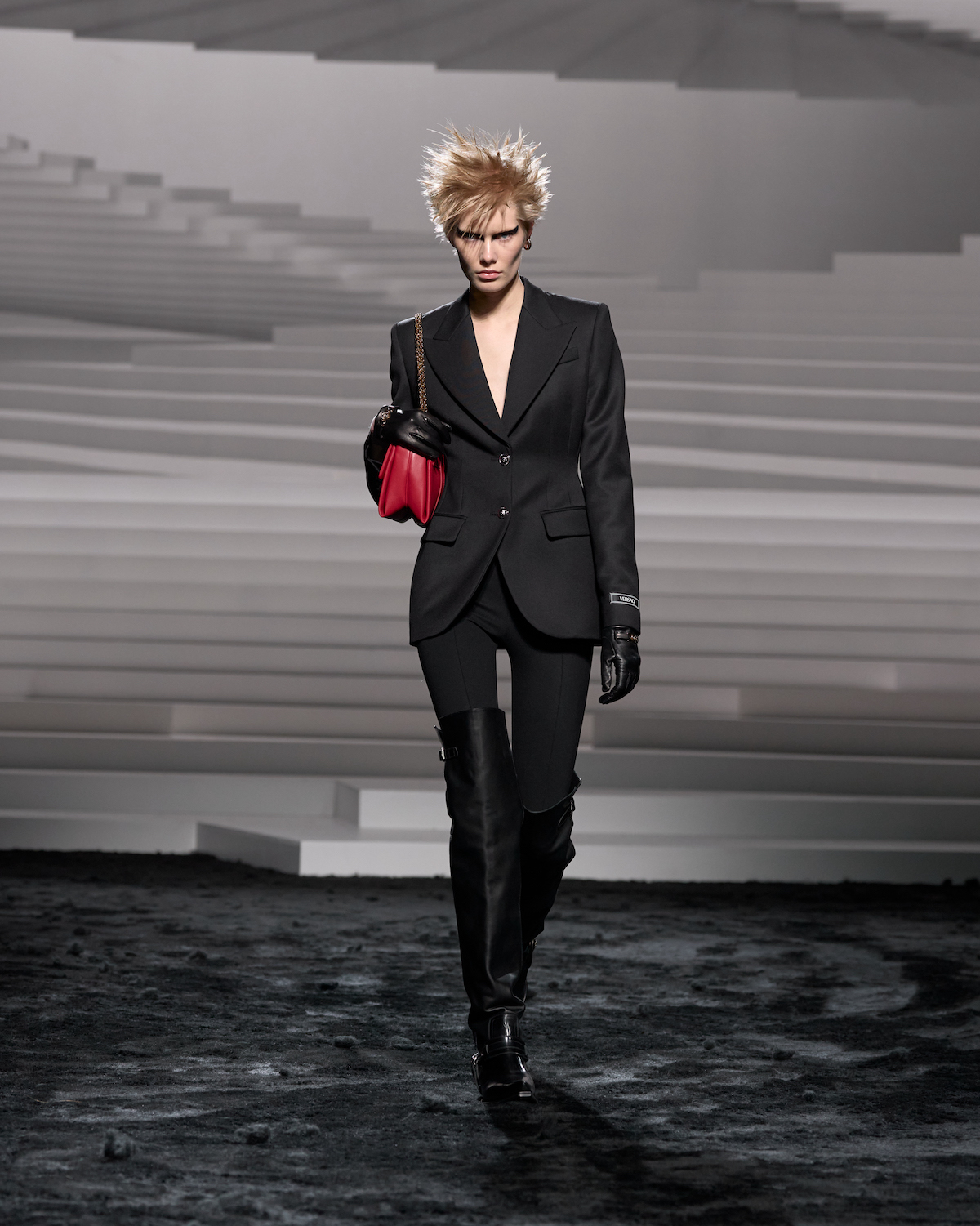
Donatella Versace closed out Friday evening’s proceedings with a stomping co-ed collection infused with a rebellious, punkish spirit – albeit in the Italian house’s hyper-glamourous style. ‘The woman is a good girl with a wild soul,’ said the designer, who formulated this juxtaposition in prim collared dresses, gold-button blazers and riffs on the tweed suit (here elongated to the point the jacket trailed along the floor) opposed with lashings of eyeliner, distressed leopard print sweaters and chainmail-covered jeans sliced open along their front. Elsewhere, a slew of molten dresses, which contoured the body into a narrow corseted waist, had requisite Versace va-va-voom (so much so, actress Anne Hathaway chose one of them to wear while she watched on from the front row). Nods to archival prints, meanwhile, appeared across both the men’s and womenswear collections. ‘This is a collection with a rebel attitude but a kind heart,’ elaborated the designer. ‘Pure lines, innovative fabrications, considered wildness. This is us. This is Versace.’
Marni
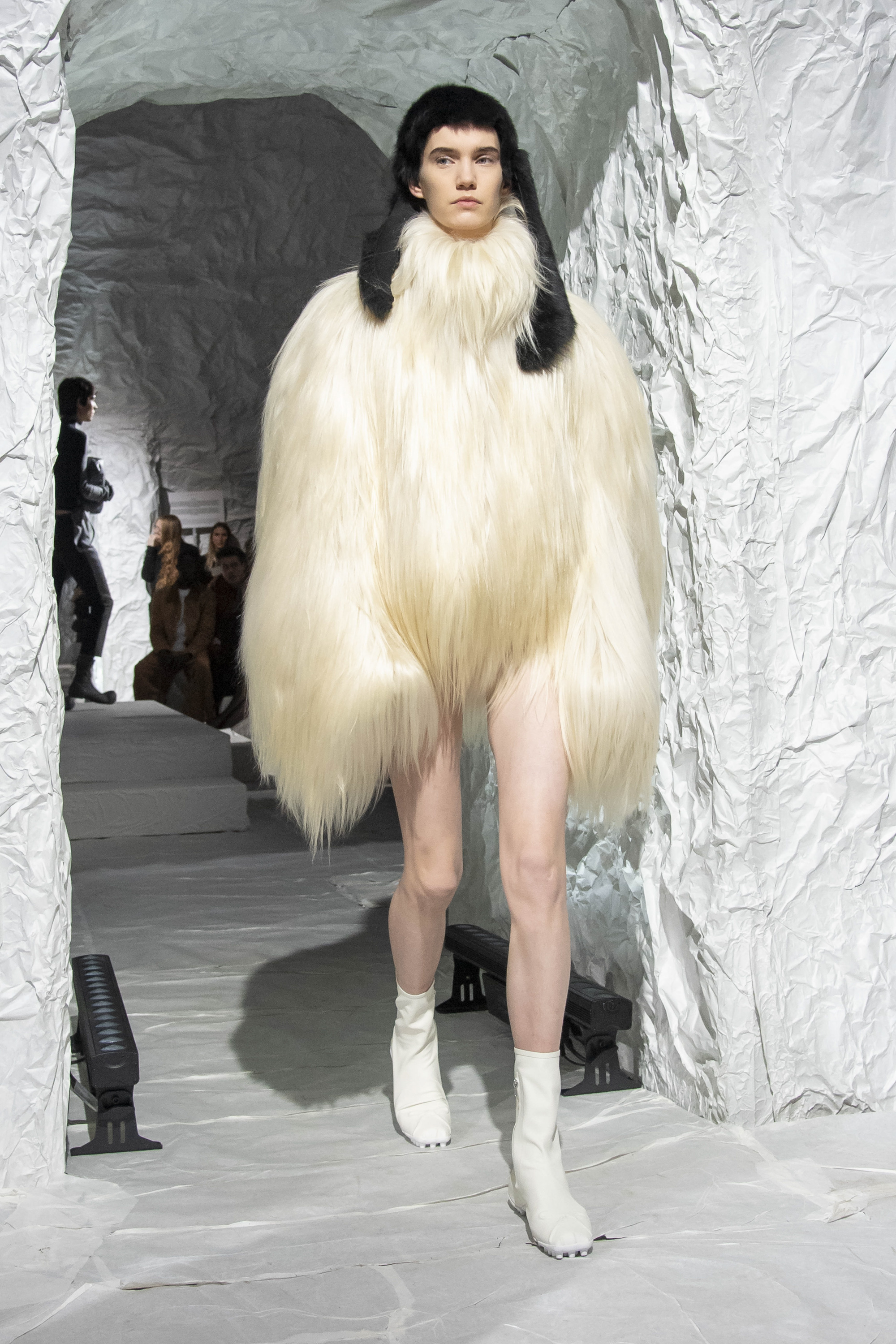
After a sojourn around the world, hosting shows in New York, Tokyo and Paris, Marni creative director Francesco Risso returned to Marni this season for a show held in the railway arches on Via Ferrante Aporti. Here, they had been entirely covered in crinkled white paper – one fellow attendee described the effect as feeling as if inside a papier maché igloo – providing a symbolic link to the collection itself, which had begun with a blank slate. Titled ‘Bring No Clothes’ (a reference to Virginia Woolf’s instructions to those visiting her home in the British countryside), Risso said that reference images were banned from the walls of the studio this season, inviting his design team to instead work by instinct and through play. ‘By casting out the idolatry of mirrors, filled to the brim with conquering dreams, we have returned to an almost animal state,’ he wrote in the show’s accompanying letter of intent. Indeed, the collection did have a primitive air: sliced panels of fur slung around models’ necks or trailing in their wake, moments of animal print, and fuzzy, enveloping textures. A mood of childlike creativity, meanwhile, was captured in a series of naively painted garments, their texture raised like an oil painting.
‘For some months now, I’ve been asking myself what it would mean to return to that original state of creation,’ elaborated Risso. ‘In a letter inviting her friends to the countryside, Virginia Woolf once wrote “bring no clothes”. I came to understand that she wasn’t suggesting they arrive naked, but simply encouraging them to strip back the punitive structures of clothing, and all their symbolic implications, because here, it’s just us. It’s a sentiment familiar to my early days in the studio – a sense of community that extended deeper and beyond our titles and roles... because here, it’s just us.’
Gucci

Sabato De Sarno’s sophomore womenswear collection continued in much the same vein as his debut, seeing the Italian designer attempt to capture the essence of his native country’s style in contemporary manner – all the while infused with a mood of insouciance and romance. ‘My dreams, as with my fashion, always converse with reality,’ he elaborated in a brief note circulated prior to the show, which was held in the industrial Fonderia Carlo Macchi. ‘Because I am not searching for another world to live in, but rather of ways to live in this world.’ For him, this means an exploration of the quotidian wardrobe enlivened with the flourishes of glamour and embellishment made possible by the Gucci atelier: mannish overcoats were adorned with a waterfall of sequins and paillettes, intricately layered lace cami tops and dresses recalled lingerie, while slouchy knit cardigans came with shimmering crystal-decorated collars. Elsewhere, tailoring was nipped and worn with abbreviated shorts (the silhouette seemed to recall the 1960s), while an impressive array of leather jackets punched with the double-G monogram showed off the house’s expertise in the material. It ended with a duo of carved strapless gowns, which were seductive in their simplicity, though with enough pizzazz to please his celebrity-filled front row (this season, it comprised Solange Knowles, Kirsten Dunst and De Sarno’s house muse, British actress Daisy Edgar-Jones). ‘[I want to] capture the extraordinary where the ordinary is expected,’ he said.
Sportmax

This season the Sportmax design team diverted from the futuristic austerity of S/S 2024’s all-white collection, looking instead towards underground icon Nico – in particular, her final 1985 album Camera Obscura – for inspiration. On the collection notes, a quote from Gerard Malanga (a poet and assistant to Andy Warhol) about the album’s imagery was chosen to encapsulate the collection’s mood. ‘Nico’s eyes seem to guard a great mystery which, hidden in aloofness, they do not want anyone to know exists,’ it read. ‘Whether or not a mystery is there, the eyes with the enigma of their absence from what surrounds them eclipse the perfection of features and form to add great magnetism’.
So the woman for this season was steeped in sensuality and intrigue, seeing models stalking the dimly lit upper corridors of the Triennale di Milano contemporary art museum on a curving mirrored catwalk (on which the season’s vertiginous heels pounded). Plunging black mini dresses rose up above the shoulder into spikes, while sharp, wide-shouldered tailoring and a recurring cinched waist (often achieved through clever layering) was designed to recall the ‘resolve of a Helmut Newton muse’. Meanwhile, Nico’s 1980s contemporaries – Grace Jones, Debbie Harry, Annie Lennox and Siouxsie Sioux – were also celebrated in the nostalgic album cover-inspired prints, dotted across the collection like a collage.
Tod’s
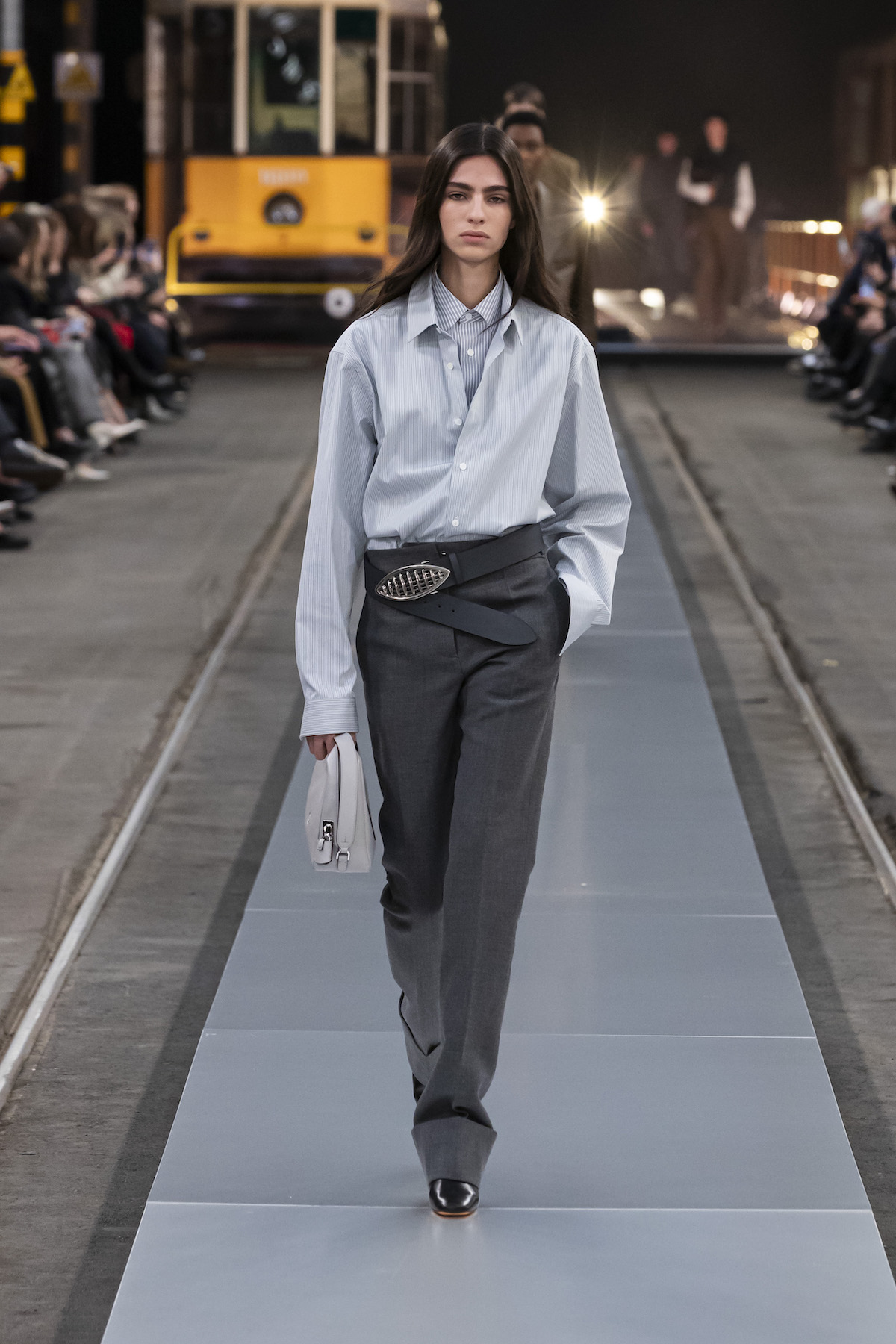
Matteo Tamburini chose the Messina Tram Depot in northern Milan to present his debut Tod’s collection, a symbolic gesture that this was a brand in forward movement (indeed, a number of the yellow Milanese trams had been adorned with the Tod’s logo for the occasion). It linked with the collection’s inspirations, which the designer said was rooted in a search for contemporary Italian elegance – one at once inspired by the energy of the street (here epitomised by the presentation, where models appeared to be rushing to catch the tram on a misted morning) and a deep-rooted appreciation for local craft. So for men and women, Tamburini attempted to create a comprehensive everyday wardrobe in luxurious style, from layers of ribbed knitwear and roomy trench coats to more dramatic leather gowns adorned with tassels (in these, there was an echo of Bottega Veneta, where Tamburini worked from 2017 to 2023). The designer was at his best, though, with the narrow, streamlined looks which opened the show, comprising sharply cut overcoats, double-layer striped shirts and gently flared tailored trousers with wide folded hems – a convincingly contemporary silhouette. As for footwear – which remains the bedrock of the brand – a version of the Gommino loafer for men with a minimal metal bar in lieu of the usual tie fastening had definite appeal, while for women the style was adorned with playful fronds of leather tassels.
Prada
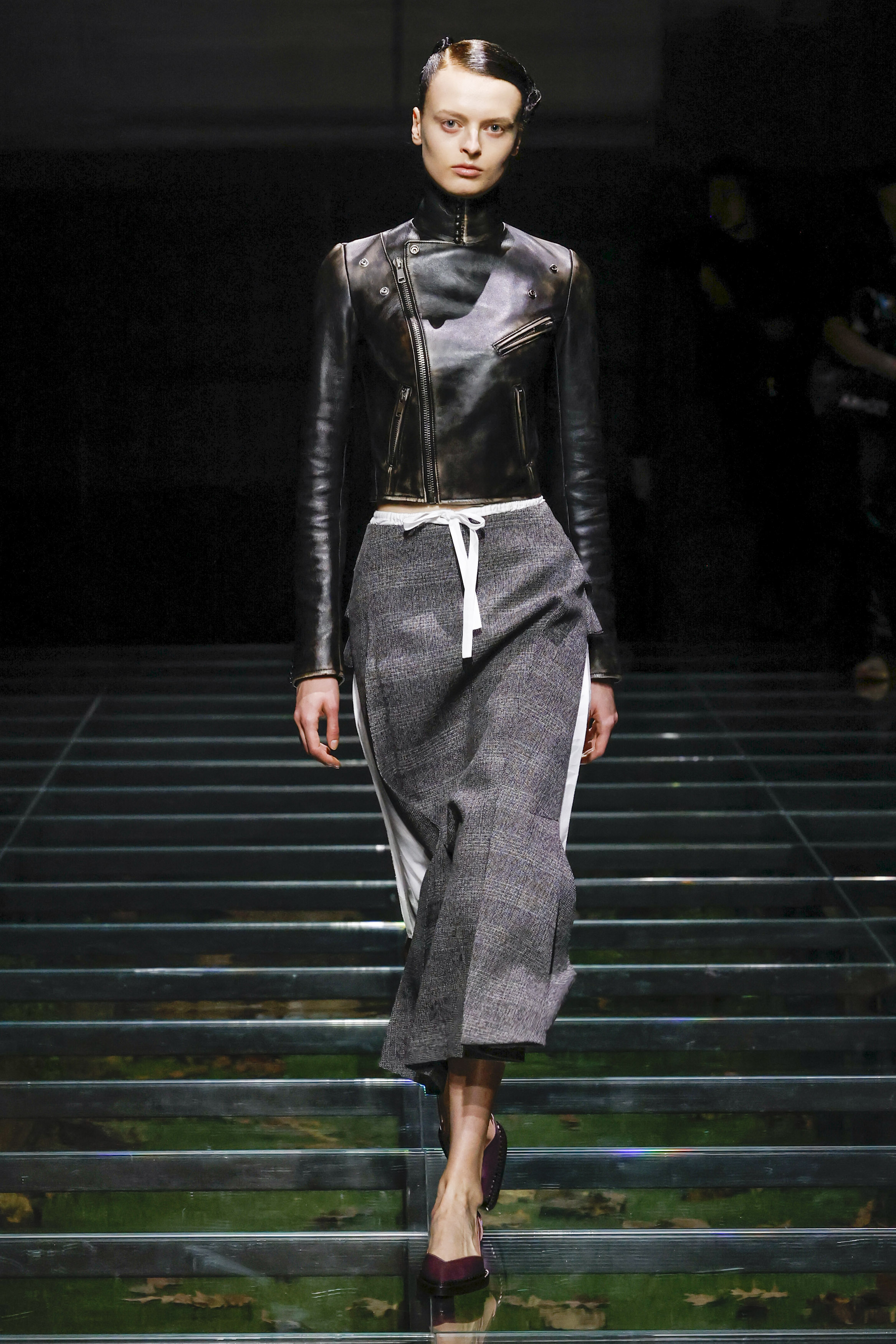
‘An instinctive attraction to history.’ So began the description of Prada’s A/W 2024 show, which was presented in the same OMA/AMO-designed space as the house’s menswear show in January, where vast Perspex tiles revealed a simulacrum of a forest floor beneath attendees’ feet (this time, the twisting lines of spinning office chairs had been removed; so too the desks and Prada-screensaver computers which had stood in the space’s entranceway). Though still striking, the set felt less prescient here – in the menswear show, its clash of the great outdoors and the corporate office was reflected in the clothing itself – with co-creative directors Miuccia Prada and Raf Simons instead looking towards ‘fragments’ of historical dress as the collection’s starting point. (Read more about OMA/AMO and Prada show sets in our Rem Koolhaas interview on 25 years of the collaboration.)
But this was not about misty-eyed nostalgia – something Miuccia Prada asserted, in typically plain-speaking style, that she ‘hates’. Rather, it was what the pair deemed an ‘emotional’ exercise – an exploration of the way clothing holds onto memories, even romance. ‘History, for me, is always connected to the lives of people,’ explained Miuccia Prada. ‘There is a sense of romance to this collection – of values of love and caring embedded in the clothes… it is not so much a theoretical statement, but a conversation about emotions. For me, these are vital ideas, they are always present in what we create. Creating beauty, creating things with love.’
So there were dresses decorated with a multitude of bows, petticoat-style slips revealed beneath sliced-away skirts, or sculpted tailoring recalling a midcentury silhouette. ‘[They] could be Victorian, 1920s, 1950s,’ said Simons of the references, which were shaken up to create the richly imagined collection. ‘This is not about a narrative history… it’s an attraction to different moments in time which now feel new.’ Other pieces worked in the other direction: a series of technical anoraks, for example, were reshaped using a historical line, imbued with new elegance.
But there was a sense of warning here, too. The profusion of feminine adornments, from bows to ruffles, had an uncanny effect (‘Why do they persist? Why do they attract?’ asked the pair via the collection notes), while suggestions of military attire lent the collection an undercurrent of lingering darkness. As one expects from Prada, this felt purposeful. ’Reflecting on history teaches us our mistakes, our strengths. The past is the only thing we have,’ said Miuccia Prada. ’This is a collection shaped by history… who we were, why we dressed like that. It’s about remembering our past, using this knowledge to move forwards.’
‘In this moment, which is such a complicated moment, it is vital to know your history. Who you are, where you come from,’ added Simons. ‘You can only realise your future if you know your past.’
Emporio Armani

Starting backwards, Emporio Armani’s A/W 2024 show ended with a flurry of snow (a micro-trend in Milan, with Jacob Cohën’s presentation earlier in the day at Teatro Lirico complete with its own blizzard of faux-snow). Through it Mr Armani’s models marched, umbrellas overheard and seemingly unfazed by the change in weather, clad here in a series of eveningwear looks in lieu of more temperature-appropriate wear – from sequinned tuxedos and shimmering crescent-moon adorned suits to crystal bra tops and sculpted evening gowns. They captured the mood of the collection, which was titled ‘Night Glow’, seeking to evoke the ‘luminous night sky’ and its changing tonal hues (the colour palette spanned midnight black to mauve, violet, jade green and tones of grey). Silhouettes, meanwhile, were designed to capture the feeling of freedom which remains at the heart of Emporio Armani – whether billowing trousers with sweatpant-style gathered hems, diaphanous organza skirts, or the boldly coloured flourishes of chubby faux fur.
Max Mara

During his three-plus decades at the helm of Max Mara, Ian Griffiths has established a canon of notable women from history to provide the inspiration for his collections. Such was the case for his A/W 2024 offering, presented on a drizzly Milanese morning in a brightly lit former industrial space on Via Giovanni Battista Piranesi. This season, it was the turn of rebellious French author Colette, who is best known for her sensual prose that at the turn of the 20th century provided a then-rare glimpse into the interior life of a woman, her passions and desires. In this spirit, what followed was a seductive collection which suggested moments of pleasure: typically enveloping overcoats in soft-to-the-touch textures, ribbed knit bands which gently cinched the waist, or asymmetric skirts draped and folded onto the body. The subtle juxtapositions which have become a signature of Griffiths’ tenure ran throughout – between weight and lightness, glamour and ease, the masculine and feminine – like his riff on a military officer’s coat or fisherman’s sweater, a nod to the way Colette would defiantly dress between genders. At the end of the press notes, a quote from the author seemed to define the liberated collection: ‘Beautiful? For whom? Why, for myself, of course.’
Fendi
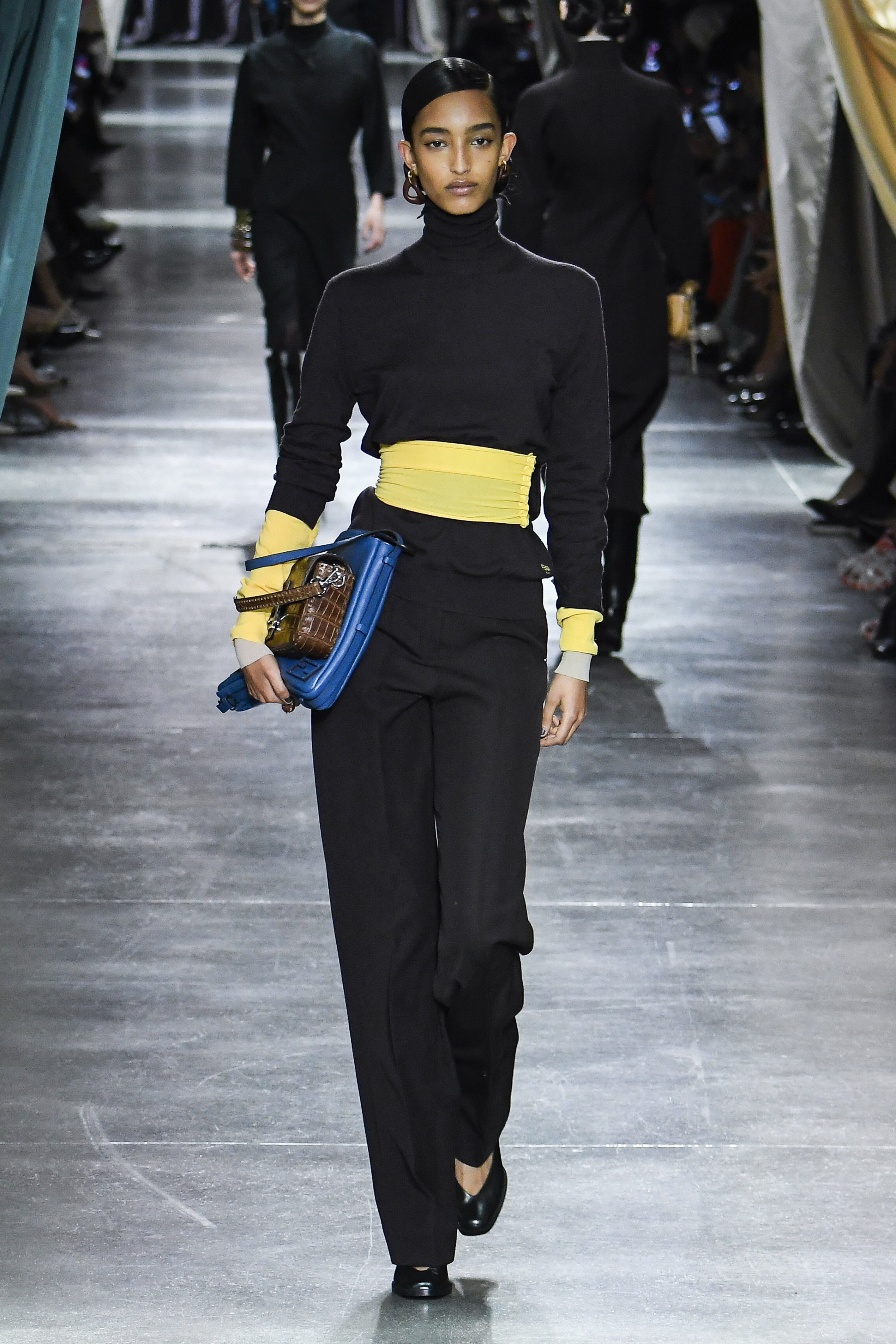
The Fendi showspace on Via Solari was divided into various rooms, their partitions constructed from enormous drapes of coloured silk. Indeed, the collection itself – which creative director of couture and womenswear Kim Jones said began by looking at archival looks from the mid-1980s – was full of such impressive contortions of fabric, whether the cinching day-glo strip of fabric which was layered over a simple black roll-neck, or the variously complex knits, which were crisscrossed over the neck or became slinky, colour-blocked ribbed dresses. The drapes also recalled those found in Roman statuary – a nod to Fendi’s home city – which also appeared as prints or as intricate embroidery on the garments themselves, part of a continuing exploration of the Italian city’s unique brand of elegance (a fascination of Jones since he started at the house, who takes particular inspiration from the personal style of house scion Delfina Delettrez Fendi, who in 2020 became Fendi’s artistic director of jewellery and in 2016 was a Wallpaper* Design Awards judge).
But delving into the archive also reminded Jones of the dress codes of his native London in the 1980s, particularly the vivid, subversive uniforms of the New Romantics and figures like performance artist and club impresario Leigh Bowery. Here, the liberated mood of the era was expressed in flourishes of polka dots (a Bowery signature) and moments of piercing colour, which contrasted rigorous, sculpted black tailoring elsewhere. ‘The sketches reminded me of London during that period: the Blitz Kids, the New Romantics, the adoption of workwear, aristocratic style, Japanese style,’ Jones explained. ‘It was a point when British subcultures and styles became global and absorbed global influences. Yet still with a British elegance in ease and not giving a damn what anybody else thinks, something that chimes with Roman style.’
No. 21
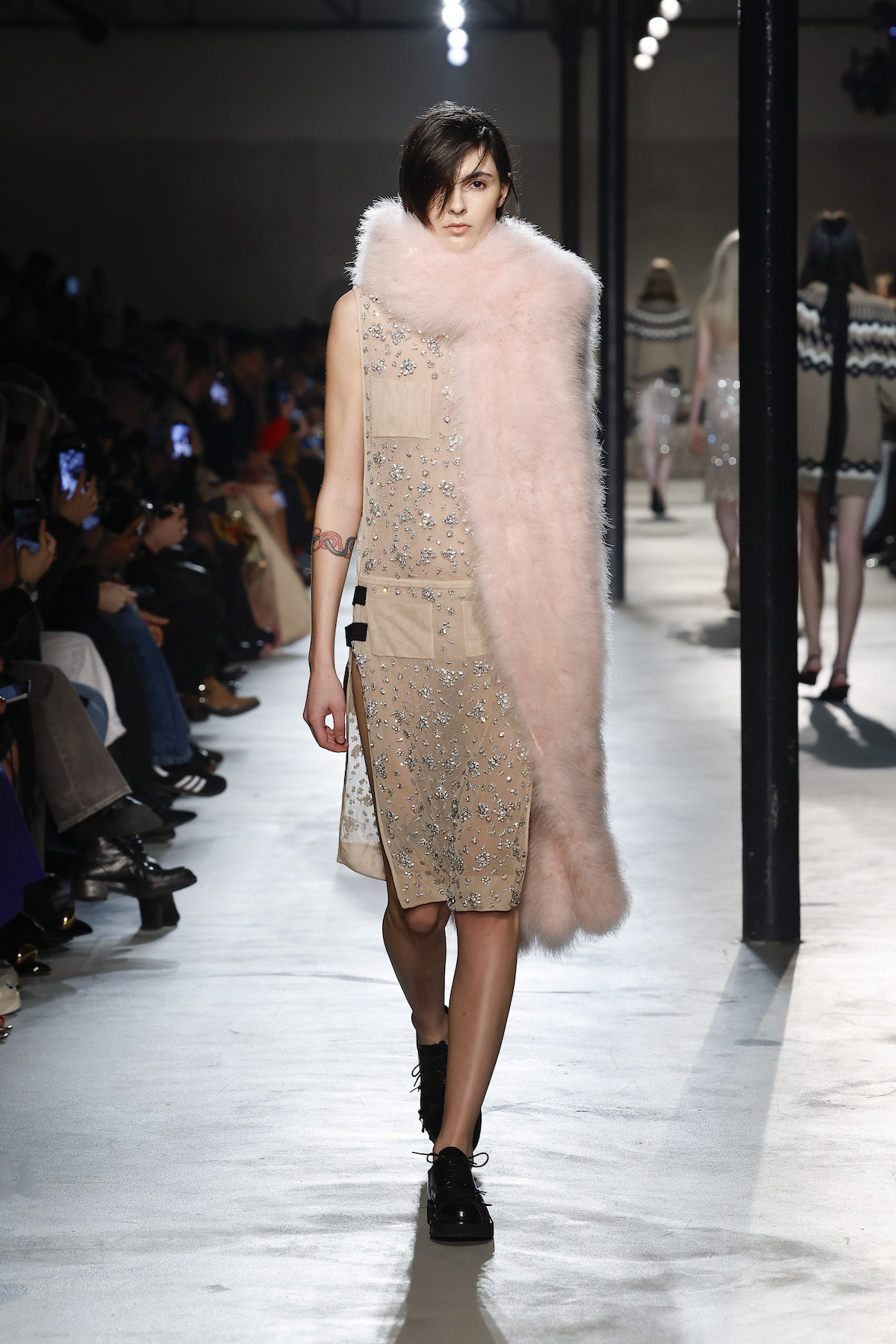
Alessandro Dell'Acqua’s always intriguing vision of womanhood at No. 21 – where underneath his clothing’s exterior beauty something darker lurks – continued this season with the Italian designer’s riff on bourgeois dress codes. He used the expression ‘bon ton’, a byword for elegance and good taste that was first used to describe British high society in the 19th century – and later reemerged during the haute couture revival of the 1980s – to encapsulate the collection’s mood. The latter era emerged here in plunging black gowns that tied at the shoulders with bows, cocooning double-breasted overcoats, or nipped tweed suiting, all of which drew inspiration from the decade’s outré haute couture collections (‘It’s as if I had cast my gaze deeply into a fashion story [and made it] come alive again,’ said Dell’Acqua of the nostalgic mood). But it was the designer’s eye for juxtaposition that continued to enchant: whether the functional, harness-style fastening which sat in the side seam of an otherwise ladylike dress dripping in crystals (and exposed the body beneath), the men’s brogues worn with a satin strapless gown, or the combination of a slouchy Fair Isle jumper with an embellished sheer skirt and pointed pumps, each combination captured the disruptive sensuality which pulsates through his work. ‘[I wanted] to capture and express a very conscious form of bourgeois eroticism,’ Dell’Acqua concluded.

